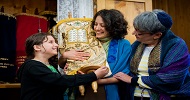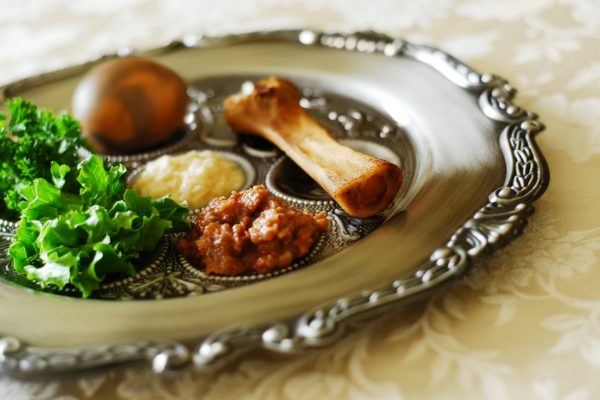Note: This article was originally published in 1994.
In the last ten years, there has been a growing awareness among women of the importance of life-cycle rituals, special celebrations and ceremonies marking important moments in our lives. We have moved from creating bat mitzvahLit. Commandment. It is traditionally held that there are 613 mitzvot (plural) in Judaism, both postive commandments (mandating actions) and negative commandments (prohibiting actions). Mitzvah has also become colloquially assumed to mean the idea of a “good deed." rituals and baby-naming ceremonies for our daughters, to celebrating special birthdays (30, 40, 50, 60), as well as weaning, menopause, croning and Rosh HodeshThe new moon, which marks the beginning of the Jewish month. According to tradition, because women did not participate in the sin of the golden calf, they were given the holiday of Rosh Chodesh. It is customary for women not to work on Rosh Chodesh.. As we have become more comfortable with our ability to create these special moments, some of us have gone on to conceive ceremonies for mourning, for healing of pain from disease, divorce or separation, for recovery from rape, incest or physical abuse.1
We have invented new ceremonies, created new music and songs, new ways to celebrate. It has been important for many of us to make these new observances resonate with a sense of the tradition from which they are drawn. We have adapted traditional rituals and infused them with new meaning. We have expanded the meaning of traditional blessings. We have dared to write new prayers. We are in truth re-creating, re-newing, re-vitalizing our lives.
In this article I will present some ideas to help us make a new ceremony fit the special occasion in our lives while still retaining a sense of our heritage as Jewish women and our connection to tradition.
1. Create a Sacred Space
In the wilderness the Jewish people built a mishkan, a portable sanctuary. Both men and women participated in its creation, by weaving fine cloth, making ritual vessels, beautifying the holy place. Before we begin our ceremony we must create our own mishkan. Whether at home, in a backyard, a beach or a forest, consider how to make the space holy for the time you will be using it. You may want to physically create sacred space by forming a circle, delineating the boundaries with ribbons or flowers, drape fabric or tallitA four-cornered garment to which ritual fringes (tzitzit/tzitzi'ot) are affixed. The knots in the fringes represent the name of God and remind us of God's commandments. The tallit is worn during prayer and can also be drawn about oneself or around the bride and groom to symbolize divine protection. around to define the area or have women in the circle hold or braid ribbons together. Some groups have indicated that the space was holy by washing the feet of guests as they entered barefoot, an act that is reminiscent of AbrahamAbraham is the first patriarch and the father of the Jewish people. He is the husband of Sarah and the father of Isaac and Ishmael. God's covenant - that we will be a great people and inherit the land of Israel - begins with Abraham and is marked by his circumcision, the first in Jewish history. His Hebrew name is Avraham. washing the feet of the angels. Some groups call up the spirits of our foremothers, SarahThe first matriarch, wife of Abraham, and mother of Isaac, whom she birthed at the age of 90. Sarah, in Rabbinic tradition, is considered holy, beautiful, and hospitable. Many prayers, particularly the Amidah (the central silent prayer), refer to God as Magen Avraham – protector of Abraham. Many Jews now add: pokehd or ezrat Sarah – guardian or helper of Sarah., RebeccaThe second Jewish matriarch, Isaac's wife, and mother to Jacob and Esau. Rebecca is an active parent, talking to God when she is pregnant and learning the fate of her children, then ultimately manipulating Isaac and the children to ensure Jacob's ascendancy. Her Hebrew name is Rivka., LeahThe third of the Jewish matriarchs, Lead is the eldest of Lavan's daughters and one of the wives of Jacob. She is the daughter whom Lavan tricks Jacob into marrying instead of his younger daughter Rachel, whom Jacob has requested to marry. Leah is mother to six of the the twelve tribes and to one daughter, Dinah. and RachelLavan's younger daughter and Jacob's beloved wife second wife (after he is initially tricked into marrying her older sister, Leah). Rachel grieves throughout her life that she is barren while Leah is so fertile. Ultimately, Rachel gives birth to Joseph and dies in childbirth with Benjamin. Rachel is remembered as compassionate (she is said to still weep for her children), and infertile women often invoke Rachel as a kind of intercessor and visit her tomb on the road to Bethlehem., as they face in each direction and create a spiritual circle. Flowers, fabrics. music, scents (be careful of people’s allergies) are all tools to create your mishkan.
2. Create a Mood
Take the time to make the transition from the outside world to this special moment. Silence or subdued background music are helpful. Begin with a song chosen to set the mood you want to create—solemn, joyous, exuberant. It is wise to explain at the outset what is about to take place in order to alleviate any discomfort that your guests may have in this unfamiliar setting.
Your ceremony will have at least three parts: the opening, the body of the ritual, and the closing. They may be parts of a whole that flow naturally one into the next or totally separate units, connected by transitions of music or prayer. You may choose to follow a format similar to a traditional service, HavdalahLit. Separation A ceremony performed on Saturday night to mark the end of Shabbat and the beginning of the week, using wine, a braided candle, and sweet-smelling spices., or even a sederLit. Order. The festive meal conducted on Passover night, in a specific order with specific rituals to symbolize aspects of the Exodus from Egypt. It is conducted following the haggadah, a book for this purpose. The mystics of Sefat also created a seder for Tu B'shvat, the new year of the trees.. Consider the amount of time your ceremony will take; the comfort zone seems to lie between half an hour or less for a simple ritual to as long as an hour and a half.
3. Select Components for the Ritual
The components of your service should be familiar, although you may choose to reinterpret them, present them in a new sequence, or create new prayers. The following list includes many familiar aspects drawn from ceremonies and services.
-Candle lighting
-Kiddush, blessing wine or grape juice. Remember guests who may be alcoholic, allergic or on special diets and provide an alternative drink for them.
-Challah, blessing bread. Find new ways of braiding or decorating it for this event
-Spices, for their sweet scent, as part of a service of separation based on Havdalah.
-Hand-washing, as we do at a seder.
-Foot-washing, as Abraham did for the angels.
-Planting a tree, a fruit tree or flowering tree, for the future generations particularly appropriate for births, birthdays, weddings, healing.
-Blessing special foods: first fruit of season, ceremonial foods i.e. PassoverPassover is a major Jewish holiday that commemorates the Jewish people's liberation from slavery and Exodus from Egypt. Its Hebrew name is Pesakh. Its name derives from the tenth plague, in which God "passed over" the homes of the Jewish firstborn, slaying only the Egyptian firstborn. Passover is celebrated for a week, and many diaspora Jews celebrate for eight days. The holiday begins at home at a seder meal and ritual the first (and sometimes second) night. Jews tell the story of the Exodus using a text called the haggadah, and eat specific food (matzah, maror, haroset, etc). foods, Tu B’Shvat seder
-Giving a gift of charity.
-Making a vow of service or good deeds to the community.
-Changing a name as AvramAbraham is the first patriarch and the father of the Jewish people. He is the husband of Sarah and the father of Isaac and Ishmael. God's covenant - that we will be a great people and inherit the land of Israel - begins with Abraham and is marked by his circumcision, the first in Jewish history. His Hebrew name is Avraham. and Sarai did when they became Abraham and Sarah.
-Donning a special garment such as a tallit or changing a garment from one dress to another, i.e. putting on a kittelA white robe in which one is buried. Also worn at Passover, on Yom Kippur, and at one's wedding as a symbol of rebirth., a white coat given to men for their marriage and worn on Yom KippurThe holiest day of the Jewish year and the culmination of a season of self-reflection. Jews fast, abstain from other worldly pleasures, and gather in prayers that last throughout the day. Following Ne'ilah, the final prayers, during which Jews envision the Gates of Repentance closing, the shofar is sounded in one long blast to conclude the holy day. It is customary to begin building one's sukkah as soon as the day ends., Passover and later used as a shroud (this is very moving in a croning ceremony).
-Cutting. Tradition says that we “cut a covenant” (the britLit. Covenant. Judaism is defined by the covenant - the contract between the Jewish people and God. God promises to make us abundant and to give us the land of Israel; we promise to obey God's commandments. This covenant begins with Abraham and is reiterated throughout the Torah. A brit milah, literally a covenant of circumcision, is often simply called a brit or bris. or circumcision is such a cutting); some people make a vow and cut an apple which when cut across contains a star.
-Reading, studying and interpreting a text from TorahThe Five Books of Moses, and the foundation of all of Jewish life and lore. The Torah is considered the heart and soul of the Jewish people, and study of the Torah is a high mitzvah. The Torah itself a scroll that is hand lettered on parchment, elaborately dressed and decorated, and stored in a decorative ark. It is chanted aloud on Mondays, Thursdays, and Shabbat, according to a yearly cycle. Sometimes "Torah" is used as a colloquial term for Jewish learning and narrative in general., classical texts,
from poetry, literature, women’s journals, etc.
-Chanting from the Torah or other classic text. Try chanting in English as well as Hebrew.
-Storytelling, one person tells a story, or one person starts the story
and each person adds a piece to the story.
-Exchanging gifts or giving gifts
-Creating amulets
-Singing, learning new songs
-Dancing. Remember some of your guests may not be able to dance.
-Prayers and blessings, both familiar and newly created. Have close friends or family create blessings.
-Mikveh, immersion in water—hot tub, hot springs, pool, particularly
useful for any healing ceremony, particularly from abuse, addiction, divorce. In nontraditional settings, friends may surround the woman being immersed, hold her, float her, support her.
-Anointing, use of water or oil —i.e. put some on eyelids, say “I bless your eyes that you may see visions of peace,” on ears, “I bless your ears that they may hear the sounds of music and of joy,” etc. This has been very succeccful blessing a woman approaching marriage or childbirth.
-Guided meditation or guided visualization
-Silence. Don’t be afraid to use silence. It can be very powerful.
4. Addressing Anger, Pain and Sorrow
Each Jewish holiday has its own special symbols which can be used or adapted. While these ritual acts can be used in your ritual, they may prove to be particularly useful for women who are dealing with pain from death of a loved one, illness, broken relationships or from emotional, physical or sexual abuse. Some women may have bottled up their anger and hurt, fearful of the depth of emotions that they are feeling. A simple ceremony which will allow them an opportunity to vent these feelings in a safe, controlled setting, with the close emotional support of a few good friends may be the tool that allows them to begin the healing process. I describe just a few possibilities, you will think of others.
- When the Torah is read, it is customary to say a misheberach, a prayer of healing.
- During the month of Elul, preceding the High Holidays, we become introspective and look at how we may have offended our friends or family and ask their forgiveness.
- At Rosh Hashonah we symbolically empty our pockets of our sins and cast the debris into the water, as we cleanse ourselves for the new year.
-
At the beginning of year we eat apples and honey for their sweetness.
Before the High Holy days we can perform another symbolic act to rid ourselves of our sins as we shlog kaporis. As a child my grandfather would swing a rooster over his head as he recited the prayers; we were each given a dime to use instead. -
During SukkotLit. Booths or huts Sukkot is the autumn harvest Festival of Booths, is celebrated starting the 15th of the Jewish month of Tishrei. Jews build booths (sukkot), symbolic of the temporary shelters used by the ancient Israelites when they wandered in the desert. Traditionally, Jews eat and sleep in the sukkah for the duration of the holiday (seven days in Israel and eight outside of Israel). The lulav (palm frond), willow, myrtle, and etrog fruit are also waved together. we build booths to live in for the week. We welcome our friends and historic visitors from the past to share the season.
On Chanukah we bring light into the darkest season by lighting candles. - As we read the story of EstherHeroine of the Purim story and Megillat (the scroll of) Esther. She is married to the king by her cousin Mordecai and ultimately saves her people from execution. at PurimLit. "Lots." A carnival holiday celebrated on the 14th of the Jewish month of Adar, commemorating the Jewish victory over the Persians as told in the Book of Esther. Purim is celebrated by reading the megilla (Book of Esther), exchanging gifts, giving money to the poor, and holding a festive meal. At the megilla reading, merrymakers are dressed in costumes, people drink, and noisemakers (graggers) are sounded whenever the villain Haman's name is mentioned., we use noisemakers to drown out the name of the evil Haman. Some communities write the name of Haman on their shoes and dance and stomp out his name.
-
Preparation for Passover includes a thorough house cleaning, when hametzLit. Leavening Any food made of grain and water which has fermented and risen and is thus prohibited to be eaten during Passover.' (food forbidden during the holiday) is burned.
At some Passover seders, drops of wine spilled to represent the plagues are collected and cast out. At others, the guests beat each other over the head with scallions. At still others, the participants walk around the dinner table, as if they were leaving the land of Egypt. - At a funeral, the mourners rip their garments in grief. The tearing of cloth can be very effective.
- Before a wedding, a plate is broken; during the wedding the groom steps on a glass to break it.
- Keening, shouting, moaning may be an expression of anger or sorrow. Friends can be supportive by participating together.
- At the close of the Sabbath, Havdalah is performed to separate the holy from the routine. The use of spices, candle and wine is a fine way to separate one event from another.
These acts of burning, tearing, cleaning, casting out, breaking, stamping, cleansing, moving can allow us to do symbolically what we would like to do in our own lives.
5. Ceremonial Objects
The use of ritual objects, garments, or other treasures from family members or friends which have historic or nostalgic connections, can add a moving note to any ritual: grandmother’s lace tablecloth, grandfather’s tallit, kiddushThe prayer recited over wine on Shabbat, holidays, and other joyous occasions. cup, candlesticks, locket. Use a huppa, marriage canopy, to stand under for special blessings. Use a large tallit to wrap several people in for blessings. Create your own ritual object as part of the service: a bowl or cup that the participants can take home, a paper-cut, a blessing written on special paper. Just use your imagination.
6. Questions to Contemplate
For many rituals, it is appropriate to think of answering three questions (three is a good number, seven and four are also mystical numbers from tradition to use):
- What do you want to leave behind?
- What do you want to remember or take with you from the past?
- What do you want to create new for the future?
You may create new questions, or reframe these.
7. Putting it All Together
While this list appears to be extensive, it is only a beginning. You can use what seems right to you and to those with whom you will do your ritual. In the beginning it is probably best to do only what you are comfortable doing, but as you getA writ of divorce. Traditionally, only a man can grant his wife a get. Liberal Jews have amended this tradition, making divorce more egalitarian. some practice, you will be moved to stretch yourself and become more innovative. Think about dividing your ceremony into three parts, opening with music and blessing, moving into the main body of the ritual, closing with blessing and music. In addition to the prayer book, look to poetry, songs, and other creative services for your sources. Remember if you put together a written service to credit the names of your sources. Good luck.2
Resources and References
There are many new sources of information about creating rituals, so many it is almost impossible to keep up. These are the ones that I have on my shelves and to which I turn for help and ideas.
Adelman, Penina V. Miriam’s Well: Rituals for Jewish Women around the Year, New York: Biblio, 1990
Adelman, Penina V., “A Drink from Miriam’s Cup: Invention of Tradition among Jewish Women,” Journal of Feminist Studies in Religion 10 (Fall 1994): 151–66.
Berrin, Susan, Celebrating the New Moon: A Rosh ChodeshThe new moon, which marks the beginning of the Jewish month. According to tradition, because women did not participate in the sin of the golden calf, they were given the holiday of Rosh Chodesh. It is customary for women not to work on Rosh Chodesh. Anthology, New Jersey, Jason Aronson, 1996
Falk, Marcia Lee, The Book of Blessings: A Feminist Jewish Reconstruction of Prayer, San Francisco: HarperSanFrancisco,, 1997.
Fine, Irene, Midlife, A Rite of Passage and The Wise Woman, A Celebration, San Diego: Woman’s Institute for Continuing Jewish Education, 1988.
Gottlieb, Lynn, She Who Dwells Within: A Feminist Vision of a Renewed Judaism, Harper/San Francisco: 1995.
Imber-Black, Evan and Janine Roberts, Rituals for Our Times: Celebrating, Healing and Changing our Lives and Our Relationships, New York: Harper Collins, 1992.
Levine, Elizabeth Resnick. A Ceremonies Sampler: New Rites, Celebrations,, and Observances of Jewish Women. San Diego: Woman’s Institute for Continuing Jewish Education. 1991.
Millgram, Abraham, Jewish Worship, Philadelphia: Jewish Publication Society, 1959. This book describes traditional worship, services and home celebrations. You may choose to use such a source to ground your ritual in tradition. Prayer books and encyclopedias can be of help, as well as the Strassfeld and Waskow books listed here.
Orenstein, Debra, editor, Lifecycles 1: Jewish Women on Life Passages and Personal Milestones, Woodstock, Vermont: Jewish Lights, 1994.
Siegel, Richard, Michael Strassfeld, Sharon Strassfeld, The Jewish Catalog, Philadelphia: Jewish Publication Society, 1973.
Spiegel, Marcia Cohn and Deborah Lipton Kremsdof, Women Speak to God: The Prayers and Poems of Jewish Women, San Diego: Woman’s Institute for Continuing Jewish Education, 1987.
Strassfeld, Michael, Sharon Strassfeld, The Second Jewish Catalog, Philadelphia: Jewish Publication Society, 1976.
Strassfeld, Michael, The Jewish Holidays: A Guide and Commentary, New York: Harper and Row, 1985.
Teubal, Savina. Simchat Hochmah in Four Centuries of Women’s Spirituality, edited by Ellen Umansky. Her service is also available on tape from SoundsWrite Productions , see information below.
Waskow, Arthur, Seasons of our Joy: A Modern Guide to the Jewish Holidays, Boston: Beacon Press,1990.
Also check: New MenorahThe seeven-branched menorah stood in the Temple, and many present-day synagogues feature the menorah. Titus' arch depicts the Romans' sacking of the Temple and theft of the menorah. A nine-branched menorah called a Hanukkiyah is lit on Hanukkah to symbolize the miracle of the oil that burned for eight days.: The Journal of ALEPH: Alliance for Jewish Renewal, 7318 Germantown Ave., Philadelphia, PA 1911999-1793 (215-247-9703) for other sources of texts and music.
Waterwheel, this quarterly newsletter from the Women’s Alliance for Theology, Ethics and Ritual (a Catholic women’s organization), presents a new ritual in each issue. While directed toward women, they are often non-gendered, and ecumenically inclusive. Jewish prayers, poetry, song and ritual are often included. 8035 13th St., Silver Spring, MD 20910-4803.
There is a wonderful selection of new music being written. I can’t possible even begin to list the artists. One good source of such music is: Sounds Write Productions, 6685 Norman Lane, San Diego, CA 92120 (619-697-6120, fax 619-697-6124). Other sources include Tara Publications 1-800-TARA-400 and Kol Ami 1-800-393-4264.
Some of the musical artists include: Debbie Friedman, Shefa Gold,
Linda Hirschorn, Penina Adelman, Miraj, HannahHannah is the mother of the prophet Samuel, who, through her prayers, is rewarded a child. She herself is also considered a prophet. Hannah's intense devotional style of prayer becomes the model, in rabbinic Judaism, for prayer in general. Tiferet Siegel.
1Adelman, Penina V. Miriam’s Well: Rituals for Jewish Women Around the Year. 2nd edition. New York: Biblio Press. 1990.
Fine, Irene. Midlife: A Rite of Passage and The Wise Woman: A Celebration. San Diego: Woman’s Institute for Continuing Jewish Education. 1988.
Levine, Elizabeth Resnick. A Ceremonies Sampler: New Rites, Celebrations, and Observances of Jewish Women. San Diego: Woman’s Institute for Continuing Jewish Education. 1991.
LilithIn the midrash (rabbinic story about the Torah story), Lilith is imagined as Adam's first wife. Because she wanted equality, she wss ultimately banished, and God provided Adam with a more obedient wife. Lilith, according to tradition, lives on as a kind of demon, causing men to have wet dreams and stealing infant boys from their cribs. Today, Lilith has been reclaimed by Jewish feminists as a symbol of women's equality.: The Jewish Women’s Magazine. Fall, 1988.
Orenstein, Debra. Lifecycles: Jewish Women on Life Passages and Personal Milestones. Woodstock, Vermont: Jewish Lights Publishing. Three volumes. Volume 1 out in 1994.
2I have drawn these ideas from Irene Fine, Savina Teubal, T. Drorah Setel, Rabbi Sue Elwell, the MikvehThe ritual bath. The waters of the mikveh symbolically purify – they are seen as waters of rebirth. A convert immerses in the mikveh as part of conversion. Many Orthodox married women go to the mikveh following their period and before resuming sexual relations. Couples go to the mikveh before being married. Many, including some men, immerse before Yom Kippur; some go every Friday before Shabbat. Ladies, ShabbatShabbat is the Sabbath day, the Day of Rest, and is observed from Friday night through Saturday night. Is set aside from the rest of the week both in honor of the fact that God rested on the seventh day after creating the world. On Shabbat, many Jews observe prohibitions from various activities designated as work. Shabbat is traditionally observed with festive meals, wine, challah, prayers, the reading and studying of Torah, conjugal relations, family time, and time with friends. Shenit and B’not Eish and many other women who have dared to create new rituals.
This article appeared in Neshama, Winter, 1994. 6:#4; used by permission of the author.













